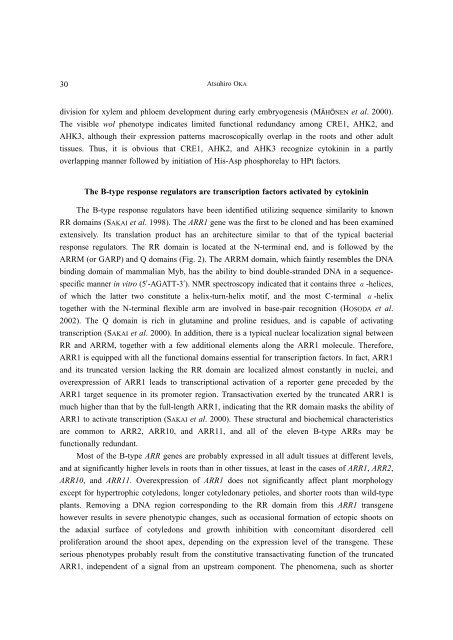No.42 - è¾²æ¥çç©è³æºç 究æ
No.42 - è¾²æ¥çç©è³æºç 究æ
No.42 - è¾²æ¥çç©è³æºç 究æ
You also want an ePaper? Increase the reach of your titles
YUMPU automatically turns print PDFs into web optimized ePapers that Google loves.
30<br />
Atsuhiro OKA<br />
division for xylem and phloem development during early embryogenesis (MÄHÖNEN et al. 2000).<br />
The visible wol phenotype indicates limited functional redundancy among CRE1, AHK2, and<br />
AHK3, although their expression patterns macroscopically overlap in the roots and other adult<br />
tissues. Thus, it is obvious that CRE1, AHK2, and AHK3 recognize cytokinin in a partly<br />
overlapping manner followed by initiation of His-Asp phosphorelay to HPt factors.<br />
The B-type response regulators are transcription factors activated by cytokinin<br />
The B-type response regulators have been identified utilizing sequence similarity to known<br />
RR domains (SAKAI et al. 1998). The ARR1 gene was the first to be cloned and has been examined<br />
extensively. Its translation product has an architecture similar to that of the typical bacterial<br />
response regulators. The RR domain is located at the N-terminal end, and is followed by the<br />
ARRM (or GARP) and Q domains (Fig. 2). The ARRM domain, which faintly resembles the DNA<br />
binding domain of mammalian Myb, has the ability to bind double-stranded DNA in a sequencespecific<br />
manner in vitro (5’-AGATT-3’). NMR spectroscopy indicated that it contains three -helices,<br />
of which the latter two constitute a helix-turn-helix motif, and the most C-terminal -helix<br />
together with the N-terminal flexible arm are involved in base-pair recognition (HOSODA et al.<br />
2002). The Q domain is rich in glutamine and proline residues, and is capable of activating<br />
transcription (SAKAI et al. 2000). In addition, there is a typical nuclear localization signal between<br />
RR and ARRM, together with a few additional elements along the ARR1 molecule. Therefore,<br />
ARR1 is equipped with all the functional domains essential for transcription factors. In fact, ARR1<br />
and its truncated version lacking the RR domain are localized almost constantly in nuclei, and<br />
overexpression of ARR1 leads to transcriptional activation of a reporter gene preceded by the<br />
ARR1 target sequence in its promoter region. Transactivation exerted by the truncated ARR1 is<br />
much higher than that by the full-length ARR1, indicating that the RR domain masks the ability of<br />
ARR1 to activate transcription (SAKAI et al. 2000). These structural and biochemical characteristics<br />
are common to ARR2, ARR10, and ARR11, and all of the eleven B-type ARRs may be<br />
functionally redundant.<br />
Most of the B-type ARR genes are probably expressed in all adult tissues at different levels,<br />
and at significantly higher levels in roots than in other tissues, at least in the cases of ARR1, ARR2,<br />
ARR10, and ARR11. Overexpression of ARR1 does not significantly affect plant morphology<br />
except for hypertrophic cotyledons, longer cotyledonary petioles, and shorter roots than wild-type<br />
plants. Removing a DNA region corresponding to the RR domain from this ARR1 transgene<br />
however results in severe phenotypic changes, such as occasional formation of ectopic shoots on<br />
the adaxial surface of cotyledons and growth inhibition with concomitant disordered cell<br />
proliferation around the shoot apex, depending on the expression level of the transgene. These<br />
serious phenotypes probably result from the constitutive transactivating function of the truncated<br />
ARR1, independent of a signal from an upstream component. The phenomena, such as shorter













